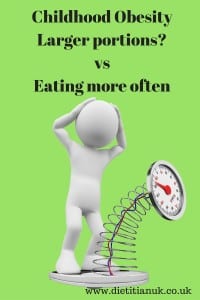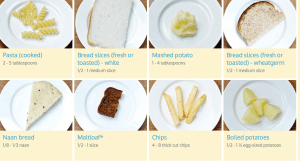One of the big connundrums around obesity is whether people put on weight because they:
1. Eat more at each meal/snack (larger portions) so eat more calories or…
2. Eat more frequently, so eat more calories.
With levels of childhood obesity rising at an alarming rate, young children is an area we need to focus more on and study in more depth. If you become overweight as a child you are more likely to be overweight as an adult too. Habits learnt in childhood are hard to change.
A study of the UK 2011 Diet and Nutrition Survey of Infants and Young Children (DNSIYC) looked at the eating habits of 2564 young children (aged 4-18 months) by asking to parents to complete diet diaries to report the childrens food intake. The results were presented in an oral presentation at the European Obesity Summit in Gothenburg (1-4th June 2016). They show that overweight children consume larger portions at meals (141 calories versus 130 calories, respectively at each eating occasion), but do not eat more frequently, than healthy weight children. This may seen small, only 11 kcals higher but if a child is eating 5 times a day this could be 56 kcals extra per day, 393kcals a week and 1703kcals extra a month. It soon adds up, so the overweight children were eating an extra 2 days worth of food each month. For every extra 24 calories (100 kJ) consumed during each meal, there was a 9% increased risk of overweight/obesity.
It was LARGER PORTIONS that were shown to be the main issue. The overweight children were eating more of the same foods: (160g of a food versus 146g).
The authors conclude: “Larger portions rather than eating more often may be a risk factor for the development of childhood overweight in early life. Further prospective studies that look at the development of excess weight over time are needed to establish causation.”
My Viewpoint:
The UK Diet and Nutrition Survey of Infants and Young Children (DNSIYC) suggests that portion sizes are larger in overweight children. I would agree that this is often the case but it is not the only issue. The research used diet diaries which are subject to under and over reporting errors.
From my experience as a dietitian and a mum, the other issue is the type of snack foods being offered to children. There are a lot of sugary snack foods available to buy in the shops and these foods seem to be used regularly as a snack item instead of fruit and vegetables. Biscuits, juices and cakes are also frequently given at toddler groups and have become the normal foods to have. Parents need to focus on the balance of the diet, ensuring children get a good intake of fruit, vegetables, wholegrains and protein foods.
Being overweight now will mean that the child is likely to struggle with their weight throughout their adult years too. So the quicker a good lifestyle of eating and being active can be established the better things will be.
On the one hand we want children to learn to eat according to appetite and to be able to regulate their intake. However that is not always possible. Some children do this intuitively and others need to be taught. I find it fascinating that if I give my 2 older children a piece of cake, my boy will eat nearly all of it very quickly, then stop when he has had enough. My girl will eat it slowly and leave some to have later on. Both eat according to their appetite but eat in a very different way. Parents need to teach children that it is ok to leave food when they are full, that all foods are healthy in moderation and that listening to their appetite cues is essential.
Second helpings is a tricky issue. I do let my children have seconds if they ask but it may only be a small spoonful if I know they have had enough. Or I may talk through with them “Are they actually still hungry, do they want to wait for the next eating occasion instead, would having fruit or vegetables be a better option?” Think through how much your child had had to eat and if it should have been enough. Are they asking for more because it is a specific meal? (my children always ask for seconds of risotto and pasta). If you feel that they have had enough then keep seconds to vegetables or salad. We have started having salad on the table each night and it is making a huge difference to my girl who is really enjoying have seconds and thirds of salad!
Good guidance on portion sizes is available here from the Infant and Toddler Forum, here is a little snap shot, you can click through to get the full guidance.
As a general rule for fruit, vegetables and wholegrain starchy foods you can use your child’s fist or palm as a portion size. I’m planning on doing a blog post showing the portions I give to my children very soon.

